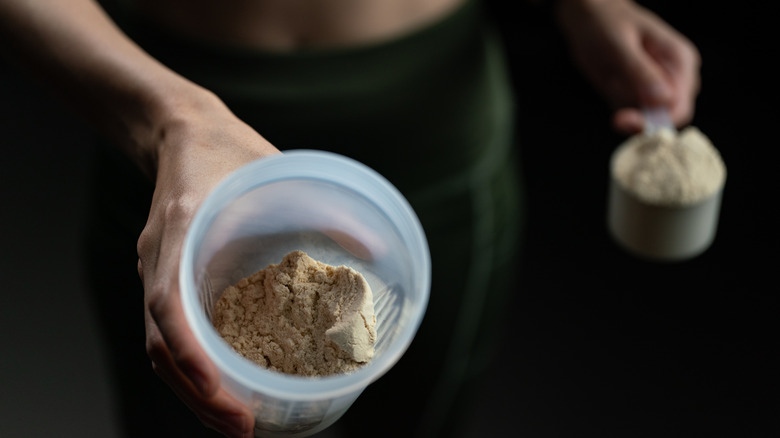These Tricks Will Help You Tone Your Belly Fat Much Easier
Are you dreaming of a flatter stomach and looking for ways to achieve those flat abs? The struggle is real. Stomach fat can be incredibly stubborn, and it's certainly okay to have some. But if your goal is to get rid of it, you can with these steps.
Why lose belly fat to achieve a toned stomach? Excess stomach fat puts you at risk for diabetes, high blood pressure, heart disease, and some cancers (via a 2012 study). Don't look to your weight on the scale to determine if your belly fat is gone, though. Your weight might be "normal" according to your body mass index (BMI) or the scale, but extra fat around your midsection, even when you appear thin, has serious health consequences (via a 2015 study).
So, what do you use to measure whether you're obese and your stomach has too much fat, if not BMI? First, use a measuring tape to get your waist size. Then, measure above your hip bones without holding your breath, and make sure the tape is straight across. WebMD explains that you're obese if your waist is larger than 34 inches for women or 40 inches for men. These tricks will help you tone your belly fat much easier.
Get your protein
There is a connection between protein intake and stomach fat. Eating meals high in protein helps you feel fuller longer and improves appetite control, helping you eat less and lose weight (via a 2011 study). High protein meals don't just help with weight loss. They also help you keep the weight off. A 2015 study found meals with at least 25 grams of protein improved appetite, cardiometabolic risk factors, fat loss, and weight management.
The recommended daily protein intake is 0.8 grams for every kilogram of body weight. For example, if you weigh 68 kilograms (150 pounds), you need 54.4 grams of protein per day. To calculate your daily protein needs, multiply your body weight in kilograms by 0.8 (via the Food and Nutrition Board Institute of Medicine National Academies).
Add foods high in protein — meats, fish, eggs, seeds, nuts, beans, lentils, and peas — to your daily diet. Some examples of plant-based protein sources are black beans, soybeans, tofu, almonds, pistachios, and cashews (via USDA MyPlate).
Get full on fiber
Eating more fiber can reduce the fat around your organs and reduce your waist size (via a 2012 study that looked at eating habits of adolescents). Increasing your fiber intake by as little as 10 grams a day will decrease the fat around your waist by 3.7% over five years (via a 2012 study). So, how much fiber should you be eating every day?
The Mayo Clinic recommends men get 30 to 38 grams of fiber daily and women get 21 to 25. Foods high in fiber include split peas, lentils, black beans, barley, green peas, broccoli, and raspberries. The American Heart Association advises looking for whole-grain fiber sources instead of refined grains, which are processed and no longer contain the whole grain. Whole-grain foods include rolled or steel-cut oatmeal, whole wheat foods, brown rice, quinoa, and popcorn. Add some fiber to your diet for a toned belly and reduced stomach fat.
Sweat it off
A 2015 study included inactive and overweight people in four different exercise groups to study the effect of eight weeks of aerobic exercise. They found that all groups doing cardio regularly reduced stomach fat, whether low- to moderate-intensity aerobic exercise for 60 minutes four times a week or the same intensity for 45 minutes three times a week.
More is better. A study with 400 inactive postmenopausal and overweight women followed them for one year. They found that the group exercising for 60 minutes five times a week lost more stomach fat than the group that did half the exercise. In addition, they achieved at least 65% of their heart rate reserve for half of their exercise time (via a 2015 study).
Cardio or aerobic exercise includes jogging, biking, swimming, dancing, rowing, or brisk walking. Also, carve out an hour a day three to five times a week to tone your torso.
Work your muscles
Don't forget about strength training to tone your torso. A 2014 study with obese teens found that a combination of cardio and strength training effectively reduces body fat. Strength training includes bodyweight exercises like squats and pushups and exercises with resistance bands and weights, whether it's with dumbbells or machines.
Insider recommends using bodyweight exercises that target your core, like planks, crunches, and pushups. You can tone your muscles with these exercises.
For a plank, Shape advises starting in a pushup position with hands and feet on the floor and a straight line from your heels to your shoulders. Rest your forearms on your mat. Engage your core and hold for 30 to 60 seconds. Per Healthline, do some crunches by starting on your back with your legs bent and hip-width apart. Tighten those abs and lift your upper body off your mat. For pushups, start in a pushup position while keeping the straight line from your heels to shoulders. Slowly lower yourself until your elbows are bent at a 90-degree angle. Push yourself back up. Add these exercises to your regular cardio routine for the best results.
Get your beauty sleep
Not getting enough sleep and getting too much sleep can lead to fat accumulation. A 2014 study found that those who slept less than six hours or more than nine hours a night had more fat growth. It seems seven to nine hours is ideal for adults. A 2017 study found that poor sleep is linked to weight gain and obesity.
Practice good sleep hygiene to get enough quality sleep. The Sleep Foundation recommends having an evening routine that helps remind your body that it's almost time to sleep. Set aside 30 minutes for relaxation before bed — yoga, stretching, meditation, reading, or listening to music, whatever helps you unwind. Keep your bedroom cool, dark, and quiet to aid sleep. That means no devices at least 30 minutes before bed. Use earplugs and an eye mask to help you sleep throughout the night. Set your alarm, and wake up at the same time each day, even on the weekends. See your doctor if you have trouble falling asleep or staying asleep.






